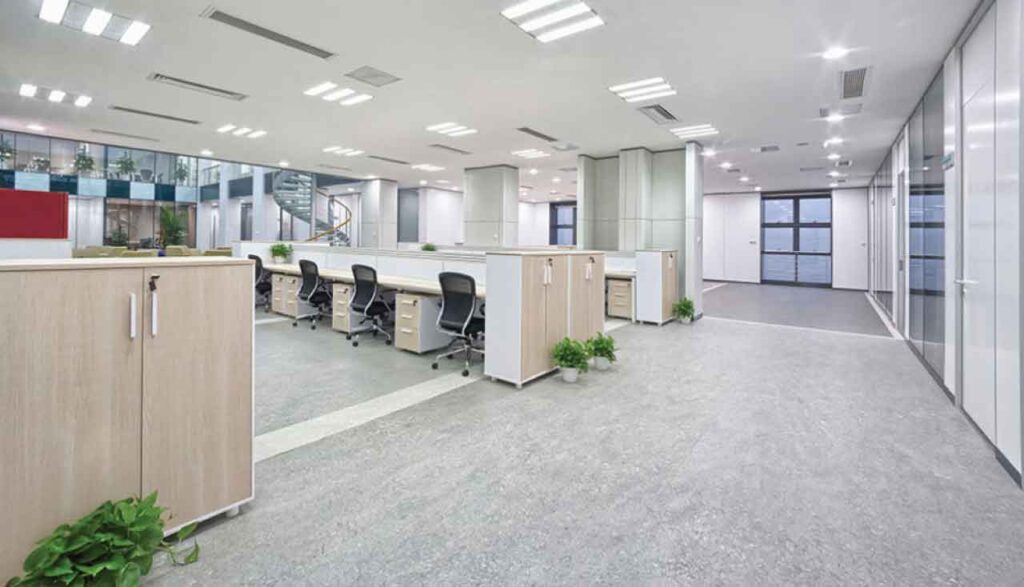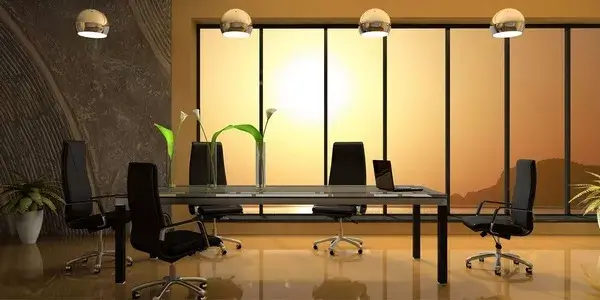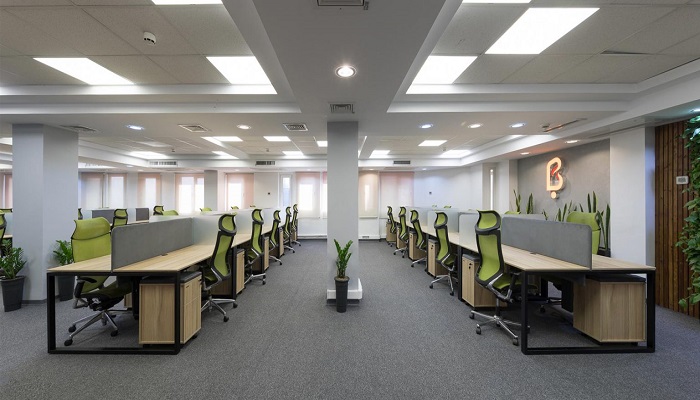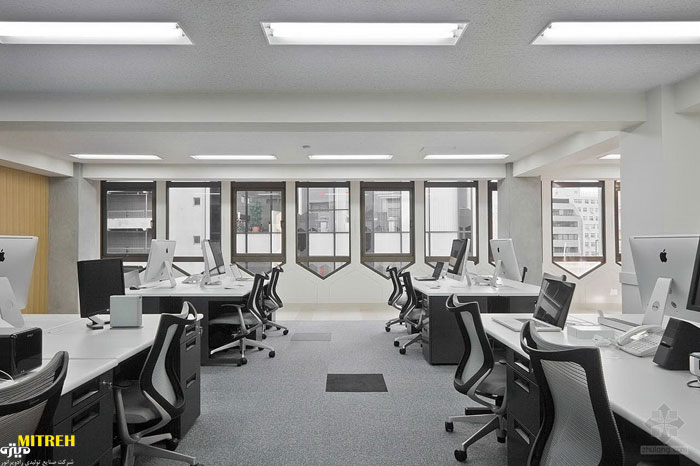The Importance of Lighting in Workspaces and Offices
Today, lighting is one of the most important aspects of interior design. Proper lighting for different areas of an office or business building, such as workstations, rooms, meeting halls, management offices, and other spaces, is a crucial principle in interior design. This is because the goal is to provide the best and most efficient lighting for the office space with minimal time and cost. Since the office is an important environment where you spend many hours, and sometimes meet with clients or customers, the lighting in your workspace directly impacts your energy levels, the client’s perception of your work and services, and ultimately has a significant effect on your career success. In this article, we from Shamin Andisheh Company will discuss the principles of office building lighting.

5 Important Tips About Workspace and Office building lighting:
- Use of Natural Light
As much as possible, use natural light. Natural light can reduce eye strain and improve employee morale.
Daylight is the best type of office lighting you can hope for—and it’s free!
Allowing natural light through large, wide windows immediately makes your office not only brighter but also more pleasant. Instead of having your employees feel enclosed and disconnected, your goal should be to encourage a connection between them and the outside world while they work. And the benefits are not insignificant.
Research by scientists indicates the following:
- Office workers with windows sleep 46 minutes more per day.
- Work environments with proper lighting saw up to a 40% increase in sales and productivity.
- 15% of employees were more creative.
- Natural light improves mood, reduces stress, and positively affects circadian rhythms.

2. Uniform Lighting in the Workspace
Uniform lighting in offices refers to the even and consistent distribution of light throughout the workspace. This type of lighting is designed to prevent the creation of distracting shadows and ensure that light is evenly spread across all areas of the space. It helps reduce eye strain and enhances visual comfort for employees.
3. Choosing the Right Lamps for Offices
- LED Lamps:
Using LED lamps is recommended due to their lower energy consumption and longer lifespan. In fact, using these lamps in the long run is more cost-effective and significantly more efficient for employee well-being. These lamps can also be adjusted based on daylight to reduce eye strain. Additionally, LED lamps do not contain mercury or other harmful substances for the environment. - 60×60 LED Panels (Recessed and Surface-Mounted):
These panels are among the most popular lights in office spaces. Due to their uniform light distribution and aesthetic appeal, these panels help prevent eye strain and glare. Because of their design, either recessed into ceiling tiles or surface-mounted, they are the first choice for spaces that require a large amount of uniform light distribution. - Recessed Round Lights:
These lights are often used in hallways, main ceilings, kitchens, and bathrooms. Recessed round lights are similar in installation and appearance to old halogen lights but provide better and more appropriate lighting. These lamps are also known as panel lights. - Linear Lights:
Linear lights provide uniform lighting that does not cause glare. The use of linear lights in office lighting gives a good visual effect to the office decor. These lights come in different geometric shapes and sizes, such as recessed, surface-mounted, and pendant designs. It is important to consider the dimensions of rooms and halls when selecting the appropriate linear lights. Today, the use of rectangular linear lights on meeting room tables is becoming more popular in office lighting.

4. Adhering to Lighting Standards in the Office
The intensity of light in office lighting has an impact on the mood of the individuals in the space. In the lighting industry, the term “lux” is used to measure light intensity. In offices and workplaces where people deal with tools such as computers, paper, and written materials, the recommended light intensity by designers is a minimum of 500 lux and a maximum of 800 lux. Ensure that the light intensity in the workspace complies with lighting standards. Insufficient lighting can lead to eye strain and headaches.
5. Using Appropriate Colors
Soft and natural colors for walls and furniture can help reflect light better and create a more pleasant workspace.
Choosing the right colors for office lighting can have a significant impact on employees’ mood and productivity. Here are some important tips about suitable colors for office lighting:
- Natural White Light:
This type of light is the closest to natural sunlight and can help reduce eye strain and increase focus. - Warm White Light:
This type of light, with warmer tones, can create a pleasant and calming atmosphere. It is ideal for areas such as break rooms or reception areas. - Cool White Light:
This type of light, with cooler tones, can help enhance alertness and concentration. It is suitable for spaces like conference rooms or work areas. - Using Soft Colors:
Soft and natural colors for walls and furniture can help better reflect light and create a more pleasant work environment. - Color Rendering Index (CRI):
Ensure that the lights used have a high Color Rendering Index (CRI) (over 80) so that colors are displayed naturally and realistically.
Types of Office Lighting
Lighting in office environments is of high importance, as it can have a significant impact on employees’ performance, well-being, and health. Depending on the type of activities and the needs of the environment, different types of lighting are used in these spaces. Below are the different types of lighting used in office environments:
- General Lighting
General lighting refers to lighting that is evenly distributed throughout the office space to provide overall illumination. This type of lighting is primarily used to ensure sufficient brightness in all areas of the workspace.
- Purpose: Provide uniform lighting for the office environment without creating too many shadows.
- Features:
- Typically uses ceiling lights or fluorescent tubes.
- Even distribution of light across the space.
- Prevents harsh shadows or strong contrasts.
2. Task Lighting
Task lighting is designed to illuminate specific areas of the office where focused activities take place. This type of lighting is essential for tasks such as writing, using a computer, reading documents, and other similar activities.
- Purpose: Provide sufficient light for specific, focused activities without straining the eyes.
- Features:
- Typically uses desk lamps or pendant lights.
- Provides more focused light in areas like work desks.
- Helps reduce eye strain during detailed tasks.
3. Accent Lighting
Accent lighting is designed to highlight a specific point in the office environment. This type of lighting is often used to create visual effects or emphasize special details such as artwork, sculptures, or architectural elements.
- Purpose: Create visual focus on a particular feature or beauty in the office space.
- Features:
- Uses spotlights or focus lights to highlight a specific area.
- Creates contrast and visual effects.
- Suitable for decorative areas or special displays.
4. Natural Lighting
Natural lighting uses natural light sources, such as sunlight, to illuminate the space. This type of lighting brings a sense of comfort and freshness to the environment and can help improve employees’ mood and productivity.
- Purpose: Use sunlight for illumination and reduce energy consumption.
- Features:
- Utilizes windows and skylights to bring in natural light.
- Creates a healthier and more natural environment for employees.
- Can reduce electricity consumption during the day.
- When used properly, it can help improve mood and reduce stress.
Tips for Choosing Office Lighting Equipment
When selecting various lighting equipment, it’s important to consider the following key points:
- Energy Consumption: Choose energy-efficient LED bulbs. LED lights help save energy and reduce costs.
- Light Quality: Use bulbs with a high CRI (Color Rendering Index). A high CRI indicates more natural light and better color differentiation.
- Task Lighting in the Office Space
- Lifespan: Opt for bulbs with a long lifespan. Bulbs with a long life require less frequent replacements, making them more cost-effective.
- Warranty and After-Sales Service: Ensure that the products come with a warranty and after-sales support, so that any issues can be resolved quickly.
Conclusion
Office lighting needs to be tailored to the specific requirements of the space. By combining natural and artificial lighting and using appropriate lighting equipment, you can achieve the best lighting that prevents eye strain and eliminates uniform lighting. Shamim Andisheh is a designer and manufacturer of various LED bulbs and surface-mounted and recessed panels. Contact us for consultation.

 English
English العربية
العربية

















